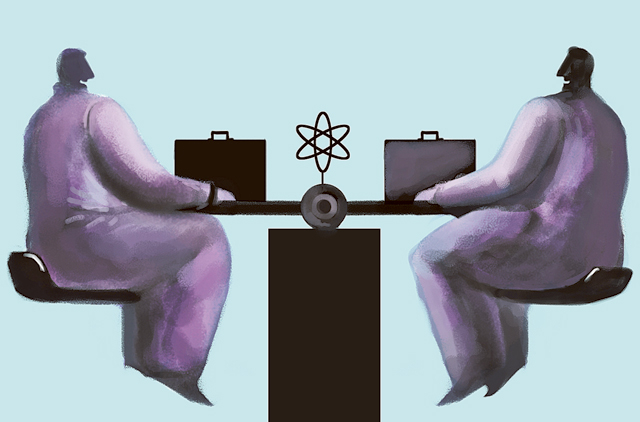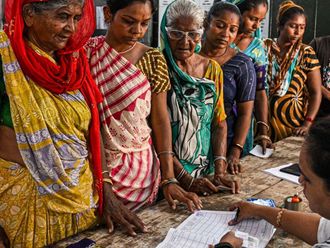Iranian Foreign Minister Javad Zarif and EU Foreign Policy Chief Catherine Ashton meet today to agree a framework for renewed nuclear talks. This sets the stage for a wider P5+1 (the United States, China, Russia, France, United Kingdom, and Germany) session with Iran later in the month with the goal of forging a final nuclear deal by November 24.
Prospects for such a historic, permanent agreement are in the balance. In recent days, new uncertainty has been injected into the talks, including as a result of the recent Iranian statement apparently linking Tehran’s cooperation with the West against Islamic State of Iraq and the Levant (Isil) in Iraq, with progress in the nuclear negotiations. Moreover, Iran’s state TV on August 25 broadcast footage which claims to show an Israeli drone shot down over near an Iranian nuclear site.
This uncertainty has combined with what appears to be faltering momentum behind the talks. Even the previously upbeat Zarif has asserted that “the chances...are low” of a final deal before November’s deadline.
Despite the fact that Iran and the P5+1 appear still to be committed to securing a robust, comprehensive agreement, there remains significant international opposition, including from conservatives in Washington and Tehran, and key US allies in the Middle East and beyond, including Israel and Canada. To date, these parties have remained relatively quiescent, but it is likely that they will become more vocal as November’s deadline nears.
Saudi Arabia has also previously expressed concern about US rapprochement with Iran too. While there still remains significant concern in Riyadh about a nuclear deal with Tehran, bilateral relations have warmed marginally recently, largely because of shared concern over Isil. This was underlined on August 26 when Iranian Deputy Foreign Minister Hussain Amir Abdollahian met with Saudi Foreign Minister Prince Saud Al Faisal — the first official high level bilateral meeting since Hassan Rouhani was elected Iranian president last year.
Perhaps the key source of contention that critics focus on is whether a permanent deal with Tehran would make the world safer by significantly reducing the prospect of an Iranian nuclear bomb. The preliminary deal that Tehran reached with the P5+1 last November saw it freeze key elements of its nuclear programme, but not (yet) permanently dismantle them.
To be sure, no deal will eliminate Iran’s ability to build a weapon, and in testimony earlier this year US Secretary of State John Kerry told Congress that it would, in theory, currently take Tehran around “two months” to produce sufficient nuclear material for a nuclear bomb. Buttressed by greater international monitoring and oversight of Iran’s programme, the P5+1 are seeking to significantly lengthen this so-called ‘break-out period’.
This is a sensitive issue with many conservatives in Tehran, including Supreme Leader Ayatollah Ali Khamenei, but a deal may be possible that could allow both Iran and the P5+1 countries to claim ‘victory’. For instance, prohibitions could be placed upon the nature and number of centrifuges which are used to enrich nuclear material.
And, the P5+1 could seek to make permanent the current temporary ban on uranium enrichment beyond 5 per cent purity as part of a final deal. This would still allow Tehran to service its nuclear energy sector.
Such compromises could give the P5+1 enough to assert it has disabled Iran’s potential to build nuclear weapons. Meanwhile, Tehran could claim that it has finally secured the international legitimacy of its longstanding position that it has the right to enrich uranium. A final agreement would be hugely significant and represent a major foreign policy win for the P5+1 (particularly the Obama administration) and Rouhani. This is not only because it would bolster reformists in Tehran, and potentially re-shape the geo-political landscape in the Middle East.
In addition, it would constitute an important victory for long-standing efforts to combat global nuclear non-proliferation. And this at a time when, according to the International Atomic Energy Agency, some 45 countries have expressed interest in joining the existing club of 30 states with nuclear energy.
For Rouhani, the deal is a crucial step in revitalising the Iranian economy which has been hit hard by years of international sanctions. Moreover, it would also allow him to outflank conservatives in Tehran, while potentially bolstering reformists, many of whom are key supporters, in advance of the 2016 Iranian parliamentary elections.
For President Barack Obama, a deal would also be a much needed foreign policy victory in the Middle East after several recent setbacks. In the past few weeks, the US administration has been on the backfoot following the territorial gains of Isil in Iraq, and the collapse of the latest round of Arab-Israeli peace negotiations and subsequent conflict in Gaza.
A deal with Iran would constitute a key part of Obama’s foreign policy legacy — one of the pillars of which is enhanced global nuclear security. As well as inter-state nuclear diplomacy, the administration has created the Nuclear Security Summit (NSS) process to counter nuclear terrorism which Obama has described as the “most immediate and extreme threat to global security”.
Since 2010, three NSS summits have been held, with a fourth in Washington DC in 2016. These have set in train a body of international work to “secure all vulnerable nuclear material around the world” by the end of Obama’s presidency in January 2017.
Taken overall, while negotiations remain in the balance, a nuclear deal remains attainable. The implications of an agreement would be potentially enormous for Iran and the wider Middle East, while also enabling Obama’s ambition of enhancing global nuclear security and consolidating his foreign policy legacy.
Andrew Hammond is an Associate at LSE IDEAS at the London School of Economics, and a former Special Adviser in the UK Government










